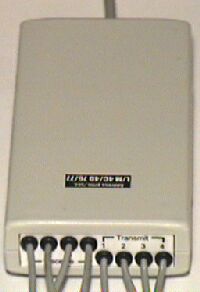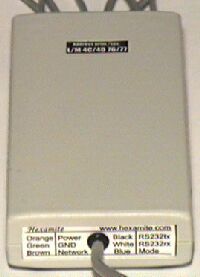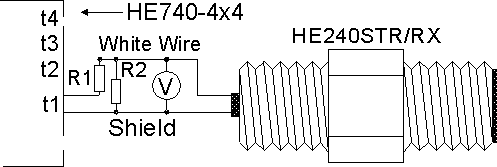|
The Hx700 series interpret the first byte as two nibbles. I.e.
instead of eight bits, the byte is read as two times four bits. The higher
significant nibble sets the 16 level reverberation control, changing this
data will change your sampling rate). Every level adds an extra time to
the scan update time T as follows
The lower significant nibble is used
to select the number of transmitters scanned. If
many scanners are ganged together via network, the lower significant
nibble of all scanners must be the same; and represent the total
transmission channels scanned through all the devices. Since one
nibble only counts to 16, the largest size positioning array achievable
with the HE700 series is 16 by 16 or 256 positioning points in total.
This can be expanded upon request.
Byte 2: The termination byte
If the termination byte of
device 'X' is the primary address of device 'Y' on the same network,
then device, 'Y' will be prompted to transmit it's position
acquisition result once device 'X' has completed it's transmission
of it's results. { IF (the
last device in the chain has a termination byte 'Carriage return') THEN
the position acquisition cycle is repeated indefinitely with very
high sampling integrity }. The chain is started by the
hyphen transmission of the master device, and restarted by the
carriage return of the last device on the network. The device with the (numerically) lowest
primary address is always a master, the rest of the devices are slaves.
If the Hx700 is not networked and there is no device to restart the
acquisition cycle. This byte should have the decimal value 33,
hexadecimal value 21 or ASCII character "!". If the
termination byte has this value the Hx700 automatically restarts the
acquisition cycle.
Byte 3: The receive inhibit bytes
The receive inhibit bytes, allow further control to maximize the
performance of the device. This control is instrumental in both noise
reduction, and in case there is a reverberation problem. Adjusting this
byte may relinquish the need to introduce a reverberation delay. If the
object which distance is being measured, never comes very close to any of
the transmitters; then there is no need to be listening for signals in
time space where it will can never exist. In other words the receiver isn't
enabled until there is a reason to belief a signal will happen. For
optimum performance the value in this byte should be as high as
possible, but lower than so as to inhibit acceptable operation. It is up
to the user, to experiment with this value to see how it serves in each
situation. This byte can have any value between 0 and 255 or 0 and FF
hexadecimal. When set 0 then this byte doesn't do anything, but at higher
values it begins to take an effect.
|


 Network Chaining
Network Chaining 
